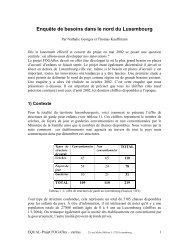Die Entwicklung integrierter familienunterstützender - Qualiflex.lu
Die Entwicklung integrierter familienunterstützender - Qualiflex.lu
Die Entwicklung integrierter familienunterstützender - Qualiflex.lu
You also want an ePaper? Increase the reach of your titles
YUMPU automatically turns print PDFs into web optimized ePapers that Google loves.
England – 2. In-depth description of selected programmes and services<br />
� Did children/families in SSLPs receive more services or experience their<br />
communities differently than children/families in comparison communities?<br />
� Did families function differently in SSLP areas than in comparison<br />
communities?<br />
� Did effects of SSLPs extend to children themselves?<br />
� How did effects on children come about?<br />
(Belsky and Melhuish, 2007).<br />
In terms of the first question, the NESS measured little change and few<br />
(if any) successes in increasing service use and building families’ impressions<br />
of their communities. There was, however, modest success regarding the<br />
second question, though the majority of families seemed to be unaffected by<br />
Sure Start. The degree to which children benefited (third question) was similarly<br />
modest and varied according to the children’s level of deprivation: relatively<br />
less deprived children benefited more than the most disadvantaged<br />
one. Finally, the benefits for children seemed to result from improved parenting.<br />
When this occurred, there was noticeable improvement in children’s<br />
social functioning. However, because only a few sites showed that Sure Start<br />
might have an impact on parenting, the NESS conc<strong>lu</strong>ded that this improvement<br />
was modest at best (Belsky and Melhuish, 2007).<br />
The eva<strong>lu</strong>ation of Full Service Extended Schools (FSESs) showed that<br />
they have had positive effects on children and families, particularly in student<br />
attainment and in-take numbers. Schools that joined the initiative in<br />
the second year were able to learn from the first round of FSESs and consequently<br />
adopted informed strategies and more readily established partnerships.<br />
Childcare was emphasised by most FSESs, but there was also an attempt<br />
to provide more rounded services. Accordingly, many sites were able<br />
to engage with particular individuals and families to bring them into the<br />
wider community (Cummings et al, 2007).<br />
However, it is still unclear as to whether FSESs have truly had an impact<br />
of the community as a whole. In addition, the programme sites had difficulty<br />
reconciling the sometimes-conflicting long-term and short-term goals,<br />
finding the need for immediate achievement to be at odds with long-term<br />
plans. Other common problems inc<strong>lu</strong>ded managing partnerships successfully,<br />
establishing sustainable funding plans, and reaching the most sociallyexc<strong>lu</strong>ded<br />
members of the population. Transportation to provide access also<br />
proved to be problematic for many sites. More broadly, since FSESs do not<br />
follow a particular model and are responsible for defining the needs of the<br />
specific community, they often found it very difficult to present a coherent,<br />
unified vision and plan of what their role would be in the community. This<br />
has negative implications for the visibility of the sites and their ability to<br />
reach all members of the community. Since many FSESs have similar problems<br />
with varying degrees of success in providing so<strong>lu</strong>tions, sharing information<br />
between sites would be a key improvement (Cummings et al, 2007).<br />
The main focus for development has been to switch from SSLPs to Children’s<br />
Centres. In a review article of Early Years services under the Labour<br />
government (1997-2007), three critical parameters are identified for eva<strong>lu</strong>ation:<br />
expansion of provision; take-up of provision; and impact on poverty<br />
and children’s development. There is evidence of both expansion and in-<br />
23



